Lecture 14 - Telescopes (10/29/98)
 Eclipses --- | ---
Interferometry
Eclipses --- | ---
Interferometry

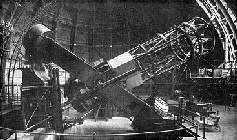
Reading:
Chapter 9 (ZG4)
The 100-inch telescope at Mount Wilson Observatory
near Los Angeles.
 |
Key Question: |
Why do we make big telescopes on
the Earth, even though the resolution is limited by the atmospheric seeing?
|
|---|
 |
Key Principle: |
Optical Ray Tracing
|
|---|
 |
Key Problem: |
What is the resolution of the
Hubble Space Telescope at its main observing wavelengths?
|
|---|
 |
Key Quote: |
|
|---|
Investigations:
- Lenses and Mirrors
- What do we mean by refraction?
- How do you shape a refracting material so that it focuses
incoming parallel rays?
- What is the focal length f of a lens?
- What is the focal plane?
- What is a thin lens?
- How does a simple lens magnify an object some nearby
distance away?
- Why is the image of a lens inverted?
- What is an f-ratio?
- What is the plate scale of a telescope with focal
length f?
- What is chromatic aberration?
- Why is a parabolic reflecting mirror equivalent to a lens?
- Brightness of Images
- What is the power received by a telescope of aperture diameter D
from a source with flux F?
- What is the brightness B of a source with angular area
theta^2 and flux F?
- What is the brightness of the image of brightness B for a telescope
of diameter D and focal length f?
- What does an eyepiece do?
- What is the magnification of a compound telescope with
objective focal length f_o, and eyepiece focal length f_e?
- Telescope Designs
- What is the difference between a refractor and a
reflector?
- Why are large-aperture refractors difficult to construct?
- What is the objective lens of a refractor?
- What is the prime focus of a telescope?
- What is the primary mirror of a reflector?
- What is a Newtonian telescope?
- Where is the Cassegrain focus?
- What are the elements of a Schmidt-Cassegrain telescope?
- Why do most older telescopes use an equatorial mounting
and modern telescopes use an altitude-azimuth mounting?
- Resolution and Diffraction
- What is the resolution or resolving power of a telescope?
- How does a telescope form an image?
- What makes the on-axis waves add up in-phase at the focus
of a telescope?
- What happens to off-axis wave fronts at the focus?
- What is the significance of the aperture plane and
image plane in an optical system?
- For two points along the aperture plane at separatipn D/2, what is the
condition for destructive interference for wavelength lambda and
small inclination angle theta?
- What is the integral of the wavefronts along the one-dimensional
aperture of diameter D?
- What do we mean when we say the resolution of a telescope is
lambda/D?
- What limits the resolution of large telescopes from the ground
to 1 arcsecond or so in the optical?
Elementary Optics (continued):
Lenses are shaped refractive materials:
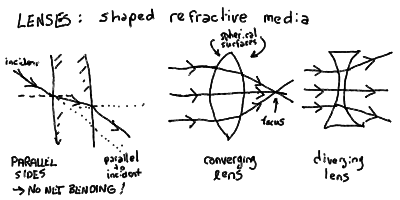
Dispersion is wavelength-dependent refraction:
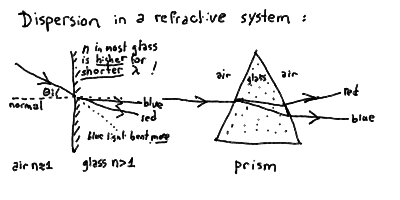
Images from Lenses and Mirrors:
Focusing in a single thin lens:
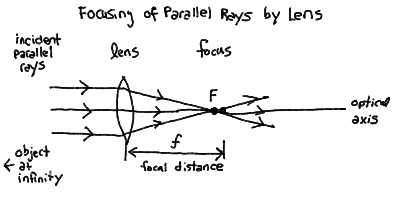
Image formation with a single thin lens, and the thin-lens equation:
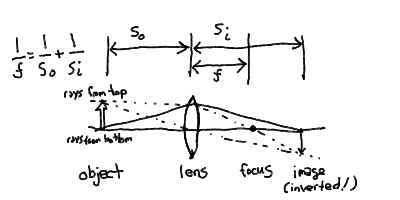
Focusing with a single paraboloidal mirror:
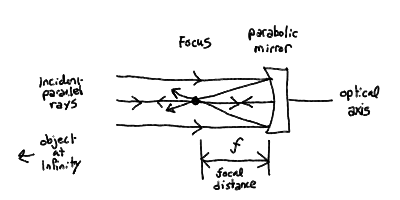
Image formation with a paraboloidal mirror:
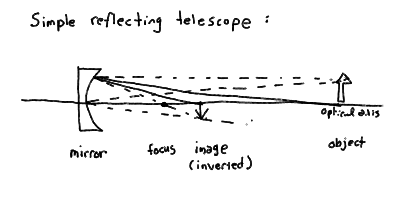
Refracting & Reflecting Telescopes:
A simple compound refracting telescope, with objective and eyepiece:
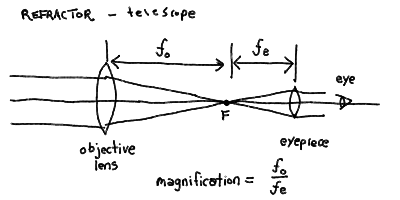
Three types of reflecting telescopes: prime focus, Newtonian, and
Cassegrain:
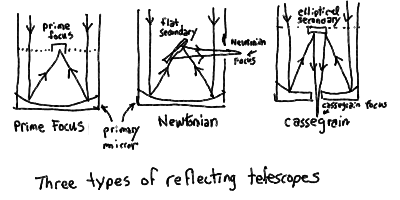
The Schmidt Camera and the Schmidt-Cassegrain Telescope:
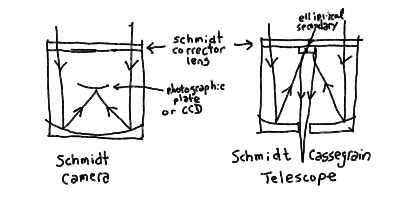
The Powers of a Telescope:
The Light Gathering Power and image brightness:
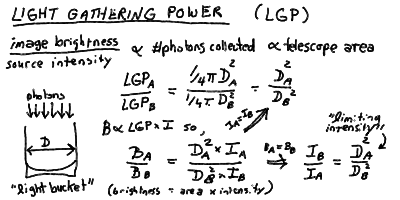
Resolving Power and resolution of telescope:
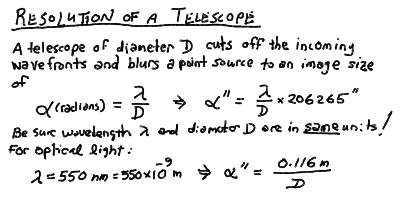
Some Tours of Observatories:
Take a guided
photographic tour of observatories I have visited.
For some images and links to observatories of the world, see this
Special Lecture.
 Prev Lecture ---
Prev Lecture ---
 Next Lecture ---
Next Lecture ---
 Astr11 Index ---
Astr11 Index ---
 Astr11 Home
Astr11 Home
smyers@nrao.edu
Steven T. Myers
 Eclipses --- | ---
Interferometry
Eclipses --- | ---
Interferometry

 Eclipses --- | ---
Interferometry
Eclipses --- | ---
Interferometry

















 Prev Lecture ---
Prev Lecture ---
 Next Lecture ---
Next Lecture ---
 Astr11 Index ---
Astr11 Index ---
 Astr11 Home
Astr11 Home